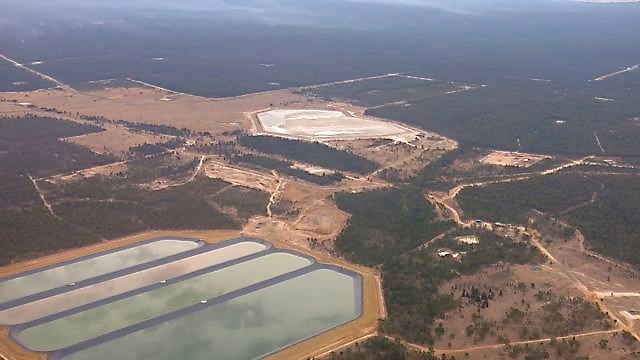The federal government has aligned itself with the unconventional gas industry, releasing a ‘Domestic Gas Plan’ that argues industries like coal seam gas will be key economic drivers carrying Australia into the future.
The strategy builds on the Abbott Government’s Energy White Paper, released last week, and presents coal seam, tight and shale gas as the way to “cement our position as an energy superpower and remain competitive”.
Welcomed by an industry, which has been blamed for massive swings against the National party in the recent New South Wales election, it’s a strategy that’s unlikely to allay the fears of rural and regional communities already up in arms.
Drew Hutton, the founder of the ‘Lock The Gate’ movement, says the plan continues the “complete lack of vision on the part of the Abbott government and of [Industry] Minister Ian Macfarlane, who has already shown he’s a creature of the gas industry”.
Earlier this week, it emerged that the government appears to have abandoned the key goal of the Paris climate talks, scheduled for later this year, to keep global temperature rises below two degrees.
“The Abbott government has put all of its hopes in fossil fuels at just the moment in history when they have come under serious challenge,” Hutton told New Matilda.
Macfarlane, though, maintains that “Australia is an energy superpower and some of our most significant opportunities for growth will come from our onshore gas assets”.
The broad-ranging gas plan acknowledges the often virulent community opposition to unconventional gas, but makes it clear the federal government is committed to a significant expansion.
It also identifies shale and tight gas resources as “the next focus for onshore unconventional gas development,” and flags the need for research in advance of their rollout.
Critics of the coal seam gas industry often point to the hasty rollout in Queensland as the harbinger of bigger problems to come. The coal seam gas boom swept the state from around 2006 on and, at least in the early days, was characterised by rushed and inadequate environmental approvals processes.
The senior bureaucrat who blew the whistle on the dodgy approvals – Simone Marsh – recently gave evidence to a senate inquiry on the blunders, but key documents have been suppressed.
Queensland Senator Glenn Lazarus recently backed Doctors For The Environment’s calls for a Royal Commission, and launched a petition which has so far garnered more than 50,000 signatures.

In New South Wales, where a major coal seam gas field is yet to be developed, the community has already organised against the industry, which Labor and the Greens are now keen to distance themselves from.
After strong campaigning at the March state election, the Greens bagged huge swings in formerly safe Nationals seats, claiming victory in Ballina and coming very close in the neighbouring seat of Lismore.
The electoral wins in the Northern Rivers came off the back of a community win last year, when thousands blockaded coal seam gas company Metgasco, effectively driving it out of the region.
Nationals’ seats in north west New South Wales and the Upper Hunter, where the Narrabri Gas Project and Gloucester gas fields are planned, also saw swings of more than 15 per cent on the first preference count.
The federal government’s endorsement of unconventional gas, while welcomed by industry, will be largely symbolic if the state governments responsible for regulating the industry take a different stance.
Hutton said that with a Labor party still in recovery, and “a supreme salesman in Premier Baird,” the LNP return to government was unsurprising, “but what they faced out there in the coal seam gas, and coal affected areas too, was the beginnings of a major – almost an uprising – in the bush.”
The industry peak body, the Australian Petroleum Production and Exploration Association, said the Domestic Gas Plan is “welcome recognition of the importance of unconventional gas production to the nation’s energy mix and economic prosperity”.
“Unconventional gas, including natural gas from coal seams, accounts for 40 per cent of production in the eastern Australian gas market,” APPEA Acting Chief Executive Paul Fennelly said.
“It also contributes significantly to our export market as Australia remains on track to be the world’s biggest exporter of liquefied natural gas by the end of the decade.”
The government said that from 2010-11, through to 2016-17, liquefied national gas investment is expected to exceed $200 billion.
However, not all economists are convinced that unconventional gas projects will help power the economy long-term.
“I think they’re vital to some of the bottom lines of the large gas companies,” the Australia Institute’s Matt Grudnoff said, “[but]I don’t think they’re part vital to the wider Australian economy”.
“Large multinational gas companies make very large profits but given that gas companies employ very few people, I don’t think the spill-over affects are going to be very large”.
“I think that fossil fuels are going to be less and less important in the world economy going forward as we take climate change more seriously,” Grudnoff said.
“While this government talks about the impacts of climate change their actions are the exact opposite of what they’re saying, so it doesn’t surprise me that the Industry Minister and the government more broadly are still keen to stay on things like gas.”
The gas lobby, and the government, suffered further embarrassment after the state election when a ‘scare campaign’ over a looming gas shortage was debunked.
The industry had warned that, because New South Wales imports up to 95 per cent of its gas from other states, a chronic shortage could strike by 2016-17, but a recent deal has seen that figure revised to 2020.
One analyst, Bruce Robertson, described the mooted shortage as a “total beat-up” in a Sydney Morning Herald article this week which explored the industry’s “cartel” qualities.
Gas prices have risen rapidly over recent years in the eastern states of NSW and Victoria, even while exports have climbed steeply, but industry and the government are refusing to follow the rest of the world in implementing a domestic reservation to keep prices down.
The federal government yesterday reiterated that it “does not support domestic reservation policies” because “they will not address the challenges and will defer future investment”.
“Instead, additional supply is needed,” the Domestic Gas Plan said. It does not explain why.
Grudnoff agrees there was never a looming shortage. “Really the problem is that CSG and shale gas and the process of fracking have a lot of environmental and health consequences,” he said.
“Rather than addressing those concerns, the gas industry decided to run a scare campaign – based on nothing – that there would be a shortage of gas, and that was blatantly untrue.”
While the government’s Domestic Gas Plan aims to allay those fears by promising an increase in scientific research and community consultation, Hutton believes there’s another fundamental problem with the government’s plan.
“They’re simply not seeing the very thing they claim to view with such a religious adherence,” he said, “and that is the market”.
Donate To New Matilda
New Matilda is a small, independent media outlet. We survive through reader contributions, and never losing a lawsuit. If you got something from this article, giving something back helps us to continue speaking truth to power. Every little bit counts.



